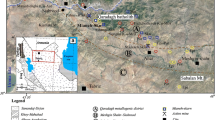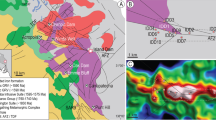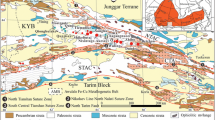Abstract
Abundant iron oxide deposits including banded iron formations, apatite iron oxide ores, and enigmatic marble/skarn-hosted magnetite deposits occur in the Palaeoproterozoic Bergslagen region, southern Sweden. During the last 100 years, the latter deposit class has been interpreted as contact metasomatic skarn deposits, metamorphosed iron formations, or metamorphosed carbonate replacement deposits. Their origin is still incompletely understood. At the Smältarmossen mine, magnetite was mined from a ca. 50-m-thick calcic skarn zone at the contact between rhyolite and stratigraphically overlying limestone. A syn-volcanic dacite porphyry which intruded the footwall has numerous apophyses that extend into the mineralized zone. Whole-rock lithogeochemical and mineral chemical analyses combined with textural analysis suggests that the skarns formed by veining and replacement of the dacite porphyry and rhyolite. These rocks were added substantial Ca and Fe, minor Mg, Mn, and LREE, as well as trace Co, Sn, U, As, and Sr. In contrast, massive magnetite formed by pervasive replacement of limestone. Tectonic fabrics in magnetite and skarn are consistent with ore formation before or early during Svecokarelian ductile deformation. Whereas a syngenetic–exhalative model has previously been suggested, our results are more compatible with magnetite formation at ca. 1.89 Ga in a contact metasomatic skarn setting associated with the dacite porphyry.



















Similar content being viewed by others

References
Allen RL, Lundström I, Ripa M, Simeonov A, Christofferson H (1996) Facies analysis of a 1.9Ga, continental margin, back-arc, felsic caldera province with diverse Zn–Pb–Ag–(Cu–Au) sulfide and Fe oxide deposits, Bergslagen Region, Sweden. Econ Geol 91:979–1008
Allen RL, Bull S, Ripa M, Jonsson R (2003) Regional stratigraphy, basin evolution, and the setting of stratabound Zn–Pb–Cu–Ag–Au deposits in Bergslagen, Sweden. Final report for SGU-FoU project 03-1203/99, jointly funded by SGU and Boliden Mineral AB
Barrett TJ, MacLean WH (1999) Volcanic sequences, lithogeochemistry, and hydrothermal alteration is some bimodal volcanic-associated massive sulfide systems. In: Barrie CT and Hannington MD (eds) Volcanic-associated massive sulfide deposits: processes and examples in modern and ancient settings. Rev Econ Geol 8:101-131
Bau M (1996) Controls on the fractionation of isovalent trace elements in magmatic and aqueous systems: evidence from Y/Ho, Zr/Hf, and lanthanide tetrad effect. Contrib Mineral Petrol 123:232–333
Dilles JH, Proffett J, Einaudi MT (2000). Magmatic and hydrothermal features of the Yerington Batholith with emphasis on the porphyry Cu(Mo) deposit in the Ann-Mason Area. In: Dilles JH, Barton, MD, Johnsson DA, Proffett JM, Einaudi MT (eds) Contrasting styles of intrusion-associated hydrothermal systems. Society of Economic Geologists Guidebook Series 32 part 1:67-99
Ding K, Seyfried WE (1992) Determination of Fe-Cl complexing in the low pressure supercritical region (NaCl fluid): iron solubility constraints on pH of subseafloor hydrothermal fluids. Geochim Cosmochim Acta 56:3681–3692
Du Rietz T (1968) Huvuddragen av Garpenbergstraktens bergbyggnad. Sver Geol Unders C 631:1–22
Einaudi MT (2000) Skarns of the Yerington District, Nevada: A triplog and commentary. In: Dilles JH, Barton MD, Johnsson DA, Proffett JM, Einaudi MT (eds) Contrasting styles of intrusion-associated hydrothermal systems. Society of Economic Geologists Guidebook Series 32 part 1:101-125
Ferry JM, Gerdes ML (1998) Chemical reactive fluid flow during metamorphism. Annu Rev Earth Planet 26:255–287
Frietsch R (1982) Alkali metasomatism in the ore-bearing metavolcanics of central Sweden. Sver Geol Unders C 791:1–54
Furlong KP, Myers JD (1985) Thermal-mechanical modeling of the role of thermal stresses and stoping in magma contamination. JVGR 24:179–191
Geijer P (1917) Falutraktens berggrund och malmfyndigheter. Sver Geol Unders C 791:1–316
Geijer P, Magnusson NH (1944) De mellansvenska järnmalmernas geologi. Sver Geol Unders Ca 35:1–654
Grant JA (1986) The Isocon diagram—a simple solution to Gresens’ equation for metasomatic alteration. Econ Geol 81:1976–1982
Grip E (1983) Malmstyrande strukturer i Bergslagen. Del 2-detaljrapport med kartor. Svenska Gruvföreningen. 214 p
Hallberg A (2003) Styles of hydrothermal alteration and accompanying chemical changes in the Sången formation, Bergslagen, Sweden, and adjacent areas. In: Ripa, M. (ed.) Economic Geology Research 2, 2001–2002. Sver Geol Unders. Rapporter och meddelanden 113:4–35
Harte B, Graham CM (1975) The graphical analysis of greenschist to amphibolite facies mineral assemblages in metabasites. J Petrol 16:347–370
Hellingwerf RH, Gatedal K, Gallagher V, Baker JH (1994) Tourmaline in the central Swedish ore district. Miner Deposita 29:189–205
Holloway JR (1976) Fluids in the evolution of granitic magmas: consequence of finite CO2 solubility. Geol Soc Am Bull 87:1513–1518
Hughes CJ (1973) Spilites, keratophyres and the igneous spectrum. Geol Mag 109:513–527
Jamtveit B, Andersen TB (1992) Morphological instabilities during rapid growth of metamorphic garnets. Psy Chem Mineral 19:176–184
Jansson NF (2011) The origin of iron ores in Bergslagen, Sweden, and their relationships with polymetallic sulphide ores. Doctoral thesis, Luleå University of Technology, ISSN: 1402-1544, 73 p
Jansson NF, Allen RL (2011a) Timing of volcanism, hydrothermal alteration and ore formation at Garpenberg, Bergslagen, Sweden. GFF 133:3–18
Jansson NF, Allen RL (2011b) The origin of skarn beds, Ryllshyttan Zn–Pb–Ag + magnetite deposit, Bergslagen, Sweden. Miner Petrol 103:49–78
Johnson DA, Barton MD (2000) Time-space development of an external brine-dominated, igneous- driven hydrothermal system: Humboldt mafic complex, western Nevada. In: Dilles JH, Barton MD, Johnson DA, Proffett JM, Einaudi MT (eds), Contrasting styles of intrusion-associated hydrothermal systems. Society of Economic Geologists Guidebook Series 32 part 1:127-143
Jonnson E (2003) Mineralogy and parageneses of Pb oxychlorides in Långban-type deposits, Bergslagen, Sweden. GFF 125:87–98
Klein C (1973) Changes in mineral assemblages with metamorphism of some banded iron-formations. Econ Geol 68:1075–1088
Kodera P, Lexa J, Rankin AH, Fallick AE (2004) Fluid evolution in a subvolcanic granodiorite pluton related to Fe and Pb–Zn mineralization, Banska Stiavnica Ore District, Slovakia. Econ Geol 99:1745–1770
Lager I (2001) The geology of the Palaeoproterozoic limestone-hosted Dannemora iron deposit. Sweden. Sver Geol Unders. Rapporter och meddelanden 107:1–49
Lagerblad B, Gorbatschev R (1985) Hydrothermal alteration as a control of regional geochemistry and ore formation in the central Baltic Shield. Geol Rundsch 74:33–49
Lindgren W (1919) Mineral deposits—2nd edition. McGraw-Hill, New York, 957 p
Liou JG, Kuniyoshi S, Ito K (1974) Experimental studies of the phase relations between greenschist and amphibolite in a basaltic system. Am J Sci 274:613–632
McDonough WF, Sun SS (1995) The composition of the Earth. Chem Geol 120:223–253
Meinert LD (1984) Mineralogy and petrology of iron skarns in Western British Columbia, Canada. Econ Geol 79:869–882
Meinert LD, Dipple, GM, Nicolescu S (2005) World skarn deposits. In: Hedenquist JW, Thompson JFH, Goldfarb RJ, Richards JP (eds) Economic geology 100th Anniversary volume 1905–2005:299–336
Ripa M (1988) Geochemistry of wall-rock alteration and of mixed volcanic-exhalative facies at the Proterozoic Stollberg Fe–Pb–Zn–Mn–Ag-deposit, Bergslagen, Sweden. Geol Mijnb 67:443–457
Smirnov VI (1976) Geology of mineral deposits. MIR, Moscow, 520 p
Stephens MB, Ripa M, Lundström I, Persson L, Bergman T, Ahl M, Wahlgren CH, Persson PH, Wickström L (2009) Synthesis of the bedrock geology in the Bergslagen region, Fennoscandian Shield, south-central Sweden. Sver Geol Unders Ba 58:1–259
Sundius N (1923) Grythyttefältets geologi. Sver Geol Unders C 312:1–354
Törnebohm AE (1875) Geognostisk beskrifning öfver Persbergets Grufvefält. Sver Geol Unders C 14:1–21
Vivallo W (1984) The Geology and origin of the Zn–Pb–Cu sulfide deposit Garpenberg, Central Sweden. Unpublished PhD thesis, Meddelande från Stockholms Universitets Geologiska Institution 250, 15 p
Vivallo W (1985) The geology and genesis of the Proterozoic massive sulfide deposit at Garpenberg, Central Sweden. Econ Geol 80:17–32
Whitney DL, Evans BW (2010) Abbreviations for names of rock-forming minerals. Am Mineral 95:185–187
Acknowledgments
Boliden Mineral and the Geological Survey of Sweden (SGU) are greatly acknowledged for funding this research, which is part of research contract 60-1451/2006. Sincere gratitude goes to Boliden Mineral staff at Garpenberg and the staff at SGU in Malå for providing access to drill cores. Alfons Berger (University of Copenhagen, Denmark) is thanked for his assistance during the microprobe analyses. Editorial handling by Pat Williams and Thomas Wagner and comments by an anonymous reviewer helped improving this paper. Magnus Ripa (SGU) is thanked for a review of an early draft.
Author information
Authors and Affiliations
Corresponding author
Additional information
Editorial handling: T. Wagner
Rights and permissions
About this article
Cite this article
Jansson, N.F., Allen, R.L. Timing and setting of skarn and iron oxide formation at the Smältarmossen calcic iron skarn deposit, Bergslagen, Sweden. Miner Deposita 48, 313–339 (2013). https://doi.org/10.1007/s00126-012-0432-5
Received:
Accepted:
Published:
Issue Date:
DOI: https://doi.org/10.1007/s00126-012-0432-5



